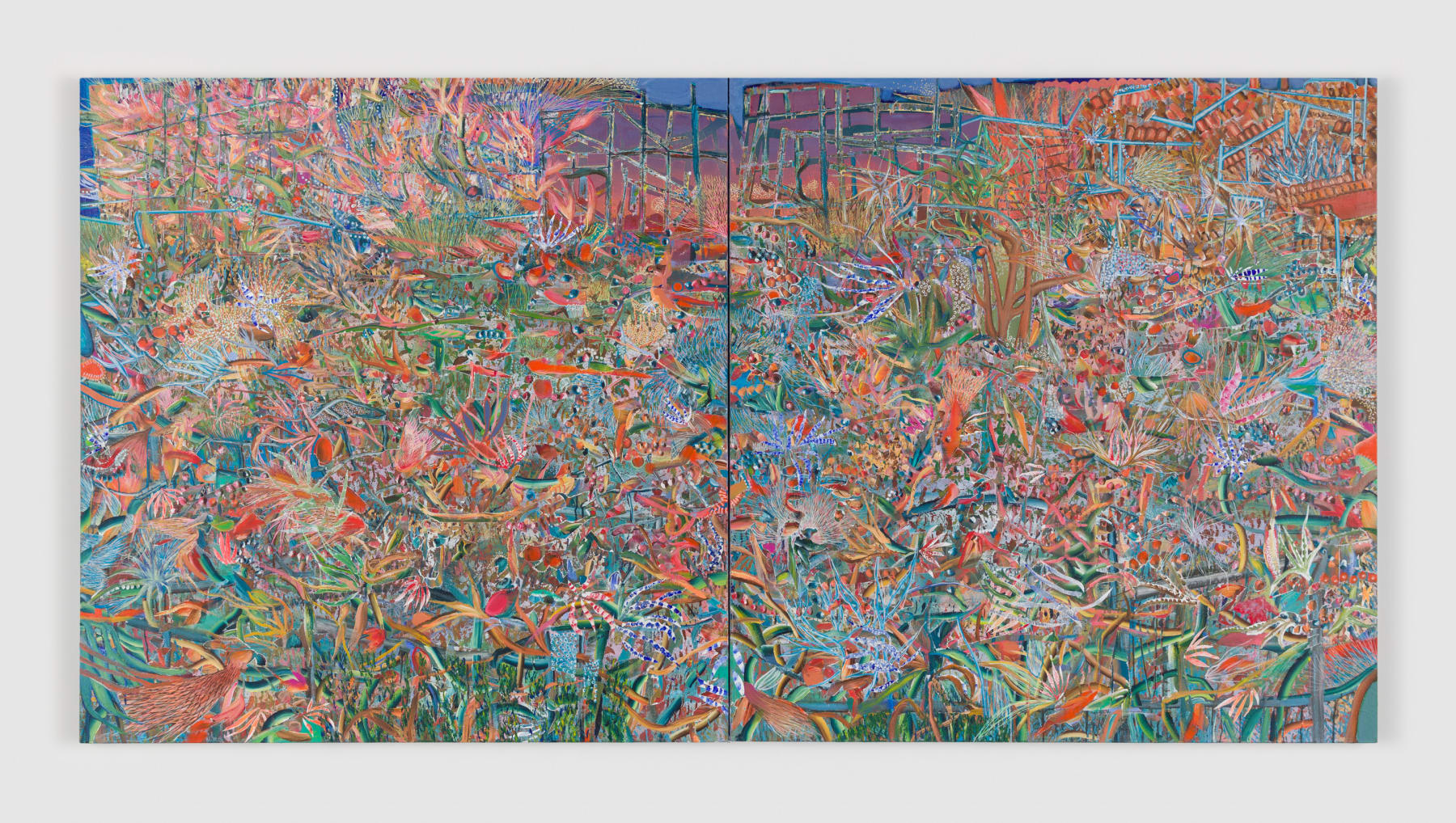Vinicius Gerheim
Dente de Leão, 2025
acrílica sobre tela
[acrylic on canvas]
[acrylic on canvas]
166 x 320 x 3.5 cm díptico
166 x 160 x 3.5 cm cada
[65 3/8 x 126 x 1 3/8 in diptych
65 3/8 x 63 x 1 3/8 in each]
6.7 kg cada [each]
13.4 kg total [total]
166 x 160 x 3.5 cm cada
[65 3/8 x 126 x 1 3/8 in diptych
65 3/8 x 63 x 1 3/8 in each]
6.7 kg cada [each]
13.4 kg total [total]
Copyright O Artista
Mais imagens
Vinicius Gerheim explora o modo como a biologia denomina o mundo, adotando sua lógica linguística de reconhecer e designar as coisas por meio de qualidades animais. Em Dente de Leão,...
Vinicius Gerheim explora o modo como a biologia denomina o mundo, adotando sua lógica linguística de reconhecer e designar as coisas por meio de qualidades animais. Em Dente de Leão, a planta carrega no nome a mordida do leão, sugerida pela forma serrilhada de suas folhas, e a imagem dos dentes que se dissipam em sementes.
Existe um estado de instabilidade provocado pelas configurações formais, pelos movimentos e pelas camadas. É uma paisagem que se mantém em tensão entre o que cresce e o que se dissolve. Ela é construída pela sobreposição de diversas camadas e de diferentes paisagens, recortadas por máscaras e transparências que se atravessam e também se comunicam.
Na sua infância, em Minas Gerais, no quintal e na roça, ouvia, através dos nomes das plantas, histórias que elas guardavam. O poder imaginativo da linguagem sempre lhe interessou, em transformar memória em linguagem, lembrança em forma. A pintura acontece como caligrafia de paisagem, um campo onde o gesto da natureza assume a potência e a delicadeza de um felino.
[Vinicius Gerheim explores the way biology names the world, adopting its linguistic logic of recognizing and designating things through animal qualities.
In Dente de Leão (Dandelion), the plant carries in its name the lion’s bite, suggested by the serrated shape of its leaves and the image of teeth that scatter into seeds.
There is a state of instability brought about by the formal configurations, by movement, and by layering. It is a landscape held in tension between what grows and what dissolves. It is built through the superimposition of multiple layers and different landscapes, cut through by masks and transparencies that intersect and also communicate.
In his childhood, in Minas Gerais — in the backyard and in the fields — he listened, through the names of plants, to the stories they kept. The imaginative power of language has always fascinated him: its ability to transform memory into language, recollection into form. Painting unfolds as a kind of landscape calligraphy — a field where the gesture of nature takes on both the strength and the delicacy of a feline.]
Existe um estado de instabilidade provocado pelas configurações formais, pelos movimentos e pelas camadas. É uma paisagem que se mantém em tensão entre o que cresce e o que se dissolve. Ela é construída pela sobreposição de diversas camadas e de diferentes paisagens, recortadas por máscaras e transparências que se atravessam e também se comunicam.
Na sua infância, em Minas Gerais, no quintal e na roça, ouvia, através dos nomes das plantas, histórias que elas guardavam. O poder imaginativo da linguagem sempre lhe interessou, em transformar memória em linguagem, lembrança em forma. A pintura acontece como caligrafia de paisagem, um campo onde o gesto da natureza assume a potência e a delicadeza de um felino.
[Vinicius Gerheim explores the way biology names the world, adopting its linguistic logic of recognizing and designating things through animal qualities.
In Dente de Leão (Dandelion), the plant carries in its name the lion’s bite, suggested by the serrated shape of its leaves and the image of teeth that scatter into seeds.
There is a state of instability brought about by the formal configurations, by movement, and by layering. It is a landscape held in tension between what grows and what dissolves. It is built through the superimposition of multiple layers and different landscapes, cut through by masks and transparencies that intersect and also communicate.
In his childhood, in Minas Gerais — in the backyard and in the fields — he listened, through the names of plants, to the stories they kept. The imaginative power of language has always fascinated him: its ability to transform memory into language, recollection into form. Painting unfolds as a kind of landscape calligraphy — a field where the gesture of nature takes on both the strength and the delicacy of a feline.]
1
de
21

